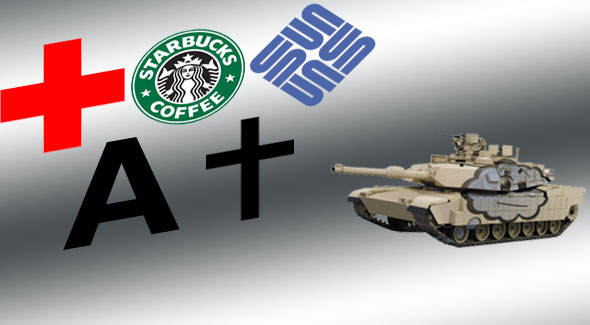
[Today, we step into the Think Tank, our steel cage match of ideas and friendly one-upsmanshp, to consider what is the best logo in the world. Read carefully all the entries and vote for your favorite at the end.]
Perich: The Red Cross
The Red Cross has the superior logo, out of everything in the world that does currently or could ever possibly use a logo, for the following reasons.

It Is What It Says It Is
Every other corporate or institutional logo hinges on some advanced symbology and semiotics to convey a particular meaning. The cursive in the Coca-Cola logo invokes nostalgia, classical traditions and an old-timey mystique. The multicolored serifs of the Google logo call up the playful simplicity of the peak of the dot-com boom.
These symbolic effects are powerful, certainly, but they take a certain amount of reaction time. The brain has to connect symbol to signifier to signified to referent. It can do this very quickly – but not instantly.
No such connection is needed with the Red Cross. The logo for the International Red Cross is a red cross. That’s what it is. There is no way you can mistake that for something else. You might think Coca-Cola is some guy’s signature, and that Google is a nonsense name made by five-year-olds, but nobody ever makes that mistake with the Red Cross. Because their logo is a cross that’s red.
It Appears Everywhere
Let’s say a friend invites you over to his house to play a few hours of some hot new first-person shooter video game on the XBox 360. You pick up the controls, fumble your way through a brief tutorial, then start shooting some bad guys. All of a sudden – whoa! Giant alien blasts through the wall next to you! The screen starts flashing, the controller starts vibrating. You’re in trouble!
What do you do? Ask your friend for help? Of course not. You’re a male between the ages of 18 and 45 (I said you were going to a friend’s house to play an FPS, right?) – you don’t ask other human beings for help!
Besides, you don’t need help. Even though this video game is completely new to you and it could be set anywhere—a German prison during the second World War, a Martian research laboratory, an urban fortress surrounded by zombies—you know exactly what you need: a health pack.
And you know exactly what it looks like:

The logo for the International Red Cross has become the universally acknowledged symbol for “healing goodies.” People who couldn’t tell you when the next blood drive is or how to perform CPR know that the White Box with the Red Cross on it contains the Stuff That Keeps You From Dying So Much.
That’s market penetration, people. Pepsi would kill for that Q score.
It’s The F#$%ing Red Cross, People
I don’t know if “importance of the organization being represented” is a valid metric for Best Logo. But if it is, I’d like you to consider the following:
Which is most important?
(A) Being able to quickly and accurately identify a source of Coca-Cola when craving a caramelized, caffeinated beverage?
(B) Being able to quickly and accurately identify an Apple product when looking to organize documents, play back digital media, or examine hypertext via networked computers?; or
(C) Being able to quickly and accurately identify the Red Cross tent when carrying your six-year-old child, his veins a fiery red from the blood infection he got while stumbling through knee-high sewage runoff after the levees north of your thirty-thousand dollar home broke, leaving you at the mercy of looting mobs and corrupt cops?
Good branding saves lives.
Stokes: Starbucks
First, the symbolic aspect: there is no earthly reason why a picture of a mermaid should be associated with coffee. There’s no particular reason why we should even think this girl is a mermaid, for that matter—although the original version is much more explicit and frankly a little disturbing. But that’s how symbols work! They have meaning simply because we decide they have meaning. Moving on.
Second, the logo as icon. If it’s an arbitrary symbol, how can it also be a non-arbitrary icon? For this to work, we have to accept that the logo can represent more than one thing. But this isn’t such a huge stretch. When we hand over our $10 for a venti cinnamon-dusted frapolation, we aren’t just buying coffee. We’re buying a slice of Seattle hippiedom. And for that, a mermaid—or even just a smiling long haired girl with a stupid hat, holding what might well in the modern version be some sort of elaborate bong – is as good an icon as you could ask for.
Finally, we have the indexical function of the logo. This is the hardest to justify… after all, when we see the Starbucks logo on a billboard, it doesn’t imply the existence of coffee. It doesn’t imply the existence of hippiedom either… billboards rarely do. But it’s absolutely an index of the other thing that the Starbucks logo represents: RAMPANT CAPITALISM.
Shechner: Sun Microsystems
I’m certainly not the first to say this, but you know what’s frickin’ awesome? The sun.
Yes, the sun is totally rad. If you’ve never noticed the enormous nuclear furnace that created, illuminates, heats, fuels and will one day inevitably consume our world, then odds are you live in the North East. Check it out, though; it’s arguably the second most powerful mindless ball of flaming gas in our solar system. And being as powerful–literally and symbolically–as it is, Earth’s favorite G2V-class* star has understandably become the totemic inspiration for all sorts of stuff. The major world religions come to mind. But way more importantly, so do a bunch of consumer products. A lot of these products use Solar imagery to adorn their brand logo, as well. It’s the modern day take on a time-honored tradition that (A) avoids the need for consumers to read anything, and (B) clarifies any problems people might have with homonyms. Besides, the meta-discourse between the average American consumer and the Brands they consume doesn’t exactly parallel the Lincoln-Douglas debates:
Capri Sun, eh? Is it made with Capri pants?
Nope. That would be a ridiculous waste of our nation’s precious Capri Pant resources.
Well, then your name is totally misleading.
It is made using the Sun, you know.
Why should I believe that?
There’s totally the ghosted image of a sun behind the logo text. Check it out.
Oh yeah! Now there’s no need for me to read the ingredients label!
&c…
So then, what to expect from the company which–rather than merely evoking Solar imagery, or deriving their name from its primal, archaic power–just takes the name whole hog unto itself? Here’s what we get:
Honk if you love C4 plane-group symmetry! …. HONK!
Now, a logo is ultimately the face that a brand uses to address its market, and I’d argue that on those terms, Sun Microsystems has created one of the most effective logos of all time. For, who is their market? It’s the sort of person who’d probably answer my opening question a bit differently:
You know what’s frickin’ awesome?
High-End Multi-Node Supercomputing Clusters.
In short, their logo, their brand identity, is Nerd-Fracking-Core. It doesn’t make any effort to evoke the actual Sun itself, lest your interpretation of the Sun be the unholy love-child of a German Expressionist painting and a Tangram. I mean, though our depictions may vary, people tend to agree that the Sun is (A) round, and (B) yellow. Yet the above image is exactly the way a true computer geek would represent it. After all, (A) Squarish things are easier to stack than round things, so this is more efficient, (B) They haven’t actually been outside in about five years, and (C) Look, buddy. Unless you’re here to debate which Linux distribution is superior, I need to get back to writing code, now.
<Snorts, pushes glasses up onto bridge of nose.>
This is a logo that accomplishes by doing, not by showing. Why show the sun itself? Sure, the name of the company is Sun, and one could pay $20 to a graphic design major at the local community college to make some shitty logo where a smiling Sun craps out mainframes all over some unicorns or what not, but what’s the point? Just let the logo be the name and nothing else… But then, the logo isn’t the *actual* name; there’s no S in it. Instead, it’s a grouping of smaller, discrete elements which, when viewed at the macroscopic level, appear to represent the S. AND, when these are assembled, they’re concatenated to give this circular, self-calling loop system: something remarkably evocative of the binary computation process itself. Remember, computers are machines that employ nested levels of abstraction to convert 1’s and 0’s into representations of text, color, sound, or (statistically speaking) photos of naked people doing unspeakable acts to one another.
The Sun Microsystems logo is hence a visual metaphor not just for this particular company’s identity, but for the identity of computation itself. To stare upon it is to know the inner workings of a mind that says, “Anything that exists can be coded; anything that can be coded is better in code than it was when it existed.”
Truly, with such mighty imagery on their side, it’s obvious that Sun will be a force to be reckoned with for some time.
(*-Suck on it, Alpha Centauri)
Sheely: American Apparel
This is the logo for the American Apparel clothing company:
That’s right, I’m making the argument that American Apparel’s logo is not the name of the company Helvetica as it appears on store signs, advertisements, and the tags of countless plain, yet brightly-colored t-shirts, deep v-necks, underwear, and leggings, but is instead the plain, colorful clothes themselves. Am App’s use of plain garments is noteworthy because of the fact that most other clothing companies create and propagate their brand identity by placing their logo on each piece of clothing that they sell, and even organizations that don’t primarily sell clothes frequently put their logo on t-shirts in order to raise their public profile.
In contrast, American Apparel sells clothes to hipsters, that fuzzy set of young, affluent, image-conscious urbanites that by and large consider themselves too cool to wear clothing advertising a particular company. By catering to (and possibly creating) this demand for logo-less clothing, American Apparel has largely become synonymous with mainstream hipsterdom, so much so that it is possible to make the inference that any item of clothing being worn by a hipster is from American Apparel. As a result, the American Apparel logo is not just the garments themselves, it is also the people who buy and wear the company’s clothes. Patrons of American Apparel are themselves an advertisement for the company, even when they aren’t wearing a single item of the brand’s clothing, even though what they think they are doing is cultivating their own “personal brand”.
There are plenty of good reasons to disagree with the argument that American Apparel has the “Best Logo in the World” (beyond pointing out the fact that I’ve chosen a logo-less logo). American Apparel’s multitude of sexually suggestive soft-porn print ads and billboards (NSFW) showcase the normatively troubling implications of treating people as logos rather than individuals. Acolytes of the brand might respond by pointing out that all of AA’s garments are made sweatshop-free in the U.S. However, even if spreading fair labor practices were the company’s main objective (and it isn’t), this would still be a less noble fusion of purpose and representation than providing relief in the aftermath of man-made or natural disasters or saving souls.
However, if we instead evaluate logos by the standard of what they are supposed to do– act as the abstraction of a corporate entity– the calculus changes completely. American Apparel has convinced millions of young people around the world that by buying logo-less clothes they are shedding the chains of brand-centric consumer culture, when they are in fact actually turning themselves into walking (or passively splayed) billboards. By not having a logo at all, American Apparel has created the ultimate logo.
Wrather (really? that guy still writes for the site?): Christianity
The best logo in the world—one could argue, the most recognizable symbol of anything anywhere (though this is not the basis of my claim that it is the best)—is the Christian cross. My argument for this is not based on religion in the slightest—I make no claim here for any theism, atheism, or -ism of any kind. It’s not based on the ubiquity of the cross, nor on its total identification with the institution(s) it stands for, nor for any value or belief it may seem to symbolize. It’s based on the fact that the cross is not a symbol at all.
As an instrument of contemporary ideas about branding, logo design relies on our conscious and subliminal associations. A logo prompts certain thoughts, hopefully positive, that are then associated with the product or service being represented. The bold, curvilinear Nike swoosh connotes dynamic movement and graceful fluidity. These are qualities to which athletes aspire, and the product—athletic shoes—is meant to fulfil them.
The Starbucks logo is nautically themed (FWIW, Stokes, Starbuck was the coffee-loving first mate in Moby Dick), and connotes luxury and indulgence (not the least, I think, because it’s a circular portrait framed in green—like money). We are mean to associate this luxury and this sense of escape and tame adventure (ever notice how many of the Bux’s coffee labels used to look like safari billboards?) with overpriced, overcooked coffee. (Don’t get me wrong. I love Starbucks. And Vampire Weekend. And my MacBook. Take that Belinkie.)
The cross doesn’t symbolize anything. The right angles at which its lines intersect do not connote a love of orthoganality. It’s not a symbol… it’s a picture. It’s an illustration. It’s a representative drawing. Specifically, it’s a drawing of the means of capital punishment used in the far reaches of the Roman empire during the early part of the common era. (Let’s pause for at least a moment and reflect on the profound strangeness of this. Imagine a religion that took as its logo the electric chair or the syringe.)
Christians believe that Jesus died this way before his resurrection, so the drawing is meant to stand for part of the story. This works both by metonymy—the cross is closely associated with Christ, who gives Christianity its name, because he was executed on one—and by synecdoche—crucifixion is one part of the ressurection.
What I’m saying is that the meaning—and, though the cross is not a symbol, I think we can agree it has many meanings—is arrived at ex post facto. Without Nike, the swoosh is still dynamic and graceful. Without Christ and the resurrection, the Cross means nothing. It is totally identified with what it represents, so much so that “representation” doesn’t seem adequate to describe the relationship. It’s transcendent—and not just because it’s religious. And that’s why it’s the best.
I mean, seriously… could you even imagine the alternative?
I tried to avoid controversy. I really did.
Want to write one in? Leave a comment below!
